
Location: Mt Waverly, VIC
Established: 1930
Architect: Alex Russell
First Played: 15th March 2017
Last Played: 19th October 2019
Magazine Ratings

91 (Current)

90 (Current)
In an effort to ensure the Australian Top 100 Golf list was completed this year (2017), a visit to Riversdale Golf Club was required. This is the second oldest club in Melbourne, quite an achievement considering the number of long established golf clubs in the city. The course is located not far from the infamous Melbourne Sandbelt region. The Riversdale Cup had been held the week before my visit, so it was still in tournament condition.

Clubhouse at Riversdale Golf Club
The course was moved a couple of times before finally being settled at its existing site in 1924, with the course being completed, albeit from temporary tees in 1927. Alex Russell was employed to carry out the design, well known for his work with Dr Alister Mackenzie at Royal Melbourne. By 2005 further changes were made to incorporate water savings, with new dams and storage areas, which were incorporated into some of the holes along the northern section.
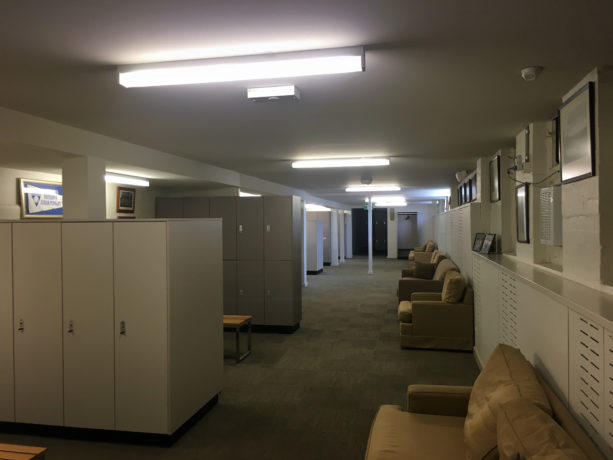
Locker Room at Riversdale Golf Club
By 2010 extensive redevelopment were carried out on the clubhouse and locker rooms. These have a modern feel and serve the members well.

Riversdale Golf Club Course Map
The course is not on the largest parcel of land, but certainly takes advantage of what is available. There are substantial elevation changes over the course, which was a surprise. Routing has been carefully considered, trying to ensure an even flow throughout the round.

Scorecard for Riversdale Golf Club
Par for the course is the more traditional 72, with four par 3 holes, four par 5 holes, whilst the remaining are par 4 holes. Play for the day was from the intermediate tees, making the holes slightly shorter that the suggested distance.
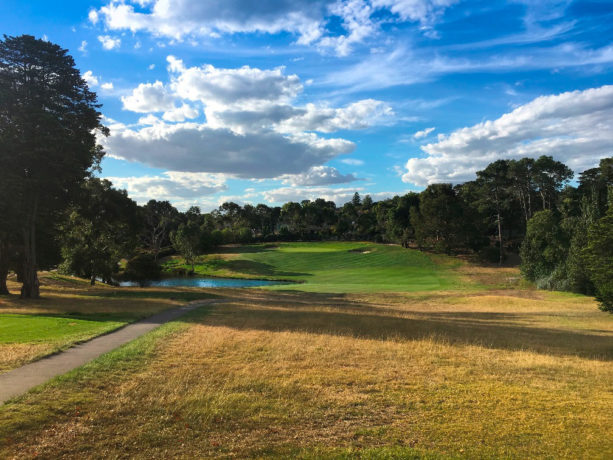
Hole 1 – 198 meter par 3
To start the round is the longest par 3 at Riversdale Golf Club. The hole plays over a gully, which has water to its left. At the bottom is a lot of short grass, but this comes to an abrupt halt when the rise to the green starts. From here it is all long rough.

Looking back from the 1st green
This green is almost in an amphitheater, with a large mound at the rear, then bunkers either side of the green. The front of the putting surface runs back towards the slope leading to the green, so anything not quite long enough, maybe repelled. Wasn’t impressed with the design of the hole. Its aesthetics were great, but practically not so much. The only way to reach the green is carrying the distance, which isn’t all that short. With the heavy rough leading up the slope to the green complex, running the ball is not going to happen. I understand that this may prevent the ball running all the way back down the hill, but some subtle plateaus could be incorporated to prevent this.

Hole 2 – 345 meter par 4
Heading back in the opposite direction to the clubhouse is a medium length par 4. To reach the fairway a small carry is required over the water hazard, near the teeing box. The fairway slightly angles away to the left, but mainly runs up a decent gradient. the best angle of attack to the green is center to left, close to the two fairway bunkers on the same side.

Clubhouse behind the 2nd green
Two bunkers are to the right of the green, whilst another three larger ones are to the left. If the pin was hard left, I would suggest a different line from the fairway. The putting surface sits slightly elevated, but relatively flat. Quite noticeable was the heavy rough surrounding the green complex. Looks like a course offering little variation on green side shots. Lob on to the green or lob onto the green. A tidy hole which offers a little strategy and will keep the player guessing.

Hole 3 – 145 meter par 3
Crossing the entrance road takes us to the shortest hole at Riversdale Golf Club. A mid length par 3 which requires a carry over shorter natural grass, plus avoiding the five bunkers at the front of the green.

Bunkers around the 3rd green
Luckily a small opening has been left between the traps, allowing the ball to be run in. There is a small ring of short grass on the surrounds, but quickly followed by heavier rough. Finding the outer bunkers leaves a difficult recovery, although there is plenty of green to work with. One thing became noticeable that the grass was inconsistent. At times many small tufts of grass was found within shorter grass. Gave the appearance of being very patchy. Enjoyable short hole.
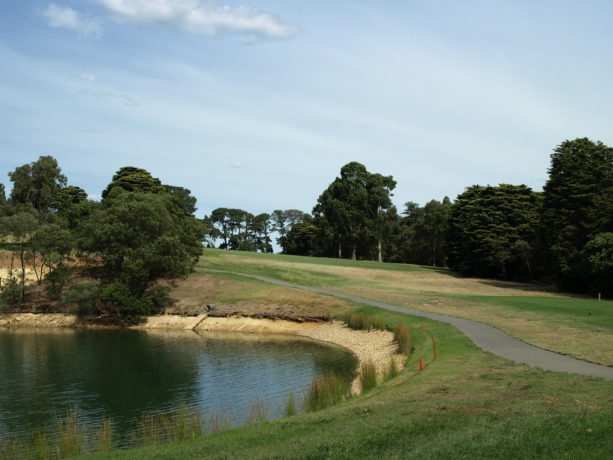
Hole 4 – 316 meter par 4
Running along the western boundary is this short par 4. Care needs to be taken when leaving the 3rd hole as you need to walk over 100 meters to reach the tee. If the group in front are still playing, you may become target practice. The tee sits with a water reservoir to the left, which is mainly in play from the back tees. Playing predominantly straight, a hill must be carried before sighting the green. Small fairway traps are found directly opposite each other, where the fairway narrows. Before this there is ample room to land the drive, although there is a camber on the fairway from right to left.

View from the 4th fairway
Being more towards the center of the fairway takes the trees out of play for the approach. The left side of the green is hidden from the front bunker, while the three on the right hand side await an errant shot. Like parts of this hole and hate others. The blind tee shot is interesting, with plenty of room to layup. Dislike traps directly opposite on the fairway, really forces a strategy. With the green angle and bunkering, there is no real line, other than down the middle to be taken.
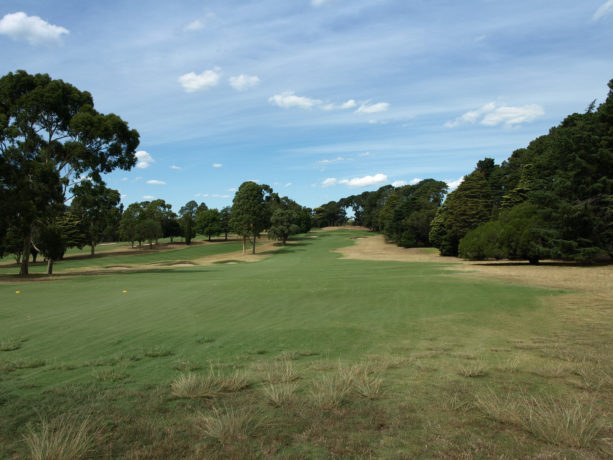
Hole 5 – 380 meter par 4
Turning along the southern boundary is the hardest hole on course, a long par 4 with a slight turn to the right. Playing from a slightly elevated position, the fairway falls away blindly until about the halfway point. The fairway is quite wide before narrowing by half towards the lowest point. Sloping slightly right to left, a group of fairway traps are found on the left, separating the 5th and 6th fairways.
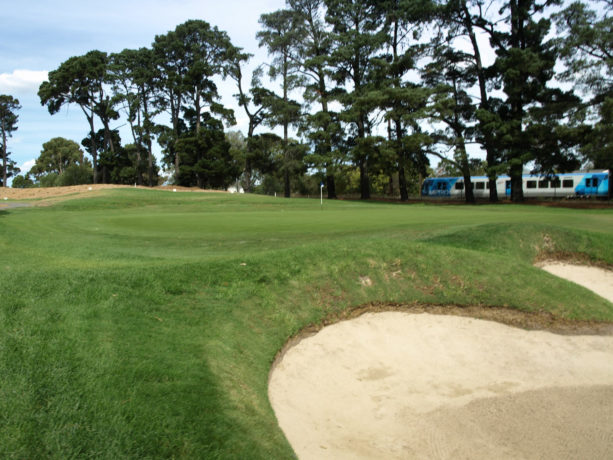
Looking across the 5th green
Approaching from the left side of the fairway, allows for a variety of shots, in particular running the ball in, on what can be a long approach. Three small bunkers are dotted on the right side, short of the green, with a larger one on the left green side, obscuring a portion of the putting surface. This is a larger area to hit with a slight mound at the rear. An ok hole, but not one of the best designed on the course. You do have the option of going for distance on the drive, but if not on line may find the narrowing rough. Having an opening to run the ball in was a positive, but there still is a small front to climb.

Hole 6 – 488 meter par 5
Heading back in the opposite direction is this longer par 5. Again play is from an elevated position, but through a narrow chute to start. The fairway slopes left to right, but again the shared bunker complex with the previous hole is in play to the left. A much wider fairway and for a longer distance leaves an easy target. Playing the second requires an uphill shot. If going for the green this is a blind shot. Two traps sit on the left at the top of the rise.
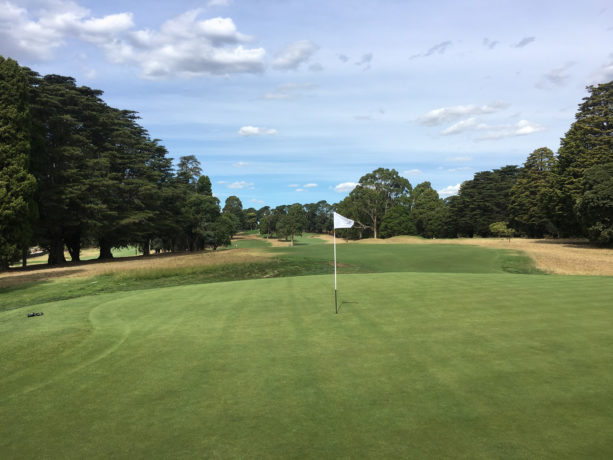
Looking back from the 6th green
Beyond the last two traps, the fairway narrows dramatically. There is a depression just before the green, making this a raised area on all sides. Two small bunkers sit at the right rear, for those playing slightly too long. A lot more short grass on the surrounds, will see any ball close to the edge potentially run away, although the thicker grass is found at the bottom of the slopes. Some though required on every shot here, offering some risk/reward shots, in particular for the second.

Hole 7 – 470 meter par 5
Consecutive par 5 holes, except this is the shortest, yet the hardest par 5. Something you do not see very often. Again a u-turn seeing us head in the opposite direction. Also another elevated tee with the hole turning to the right. The camber on the fairway is much stronger, from right to left. Similarly the fairway is quite wide until reaching its lowest point, where it starts to narrow. Trees need to be avoided down the right side, otherwise an impossible shot awaits.

Steeper slope on the 7th fairway
The approach is uphill, with bunkers dotted along the way on either side of the fairway. A large area is found to the left of the fairway, which could see a lot of play, due to the large camber in the fairway slope.

Looking back from the 7th green
Two traps are found front left, with another sitting on the right. Quite a lot of the bunkers at Woodlands Golf Club are fairway small, almost resembling pot bunkers. The green complex has slopes leading away on most sides, except the right. It also angles away slightly to the right. I can see why this hole plays as the hardest par 5. Cambering of the fairway has a lot to do with this, with the player needing to hit to the right, close to the trees, due to the stance required.

Hole 8 – 352 meter par 4
Next is a mid length par 4 which has a slight turn to the right. From the tee the fairway falls away, continuing until the green is reached. Trees closer to the tee make the fairway appear narrower than it actually is. There is no real line to take, although playing closer to the right hand side may shorten the hole.

Looking back from the 8th green
Bunkers are found on either side of the green, the right more forward, the left towards the rear. The fairway almost extends into the green, so a variety of shots can be played here. Again the surrounds are quite thick, right up to the putting surface. This really seems to be devoid of much strategy, other than staying out of the trees.

Hole 9 – 306 meter par 4
Finishing the front loop is a short par 4, which again turns to the right. Seems like the last four holes played like this. The fairway has a strong camber left to right. At the turn it slopes away from the tee, but also finds bunkers staggered on either side.
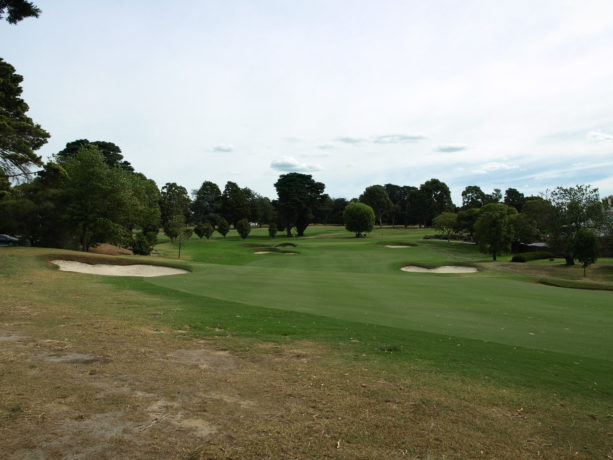
View from of the 9th fairway
The fairway falls away at the turn, before rising towards the green. Traps down the right are in play for those trying to cut the corner, shortening the hole, but also the better angle to most pin positions. There is a small false front to the green, so carrying the ball onto the green is the best way to play. Overall a good short par four, but I do question the left bunker on the fairway. An approach from this side would not be preferred, with traps front left obscuring the green.


Hole marker and pin flag
The hole markers have all of the usual information, but almost remind me of grave stones due to the shape. The pin flags have the clubs logo subtly in the corner.

Hole 10 – 251 meter par 4
Starting the second loop is the shortest par 4 on the course. A small gully must be carried at which point the fairway starts. It is not long before the hole doglegs to the left. Two bunkers are on the outside of the turn to catch any balls that may go too long.

Looking down the 10th fairway
Some maybe tempted to go straight for the green, but the risk is not really worth while in my opinion. Around 35 meters short of the green, the fairway stops, at which point thick rough is found. Four bunkers are also in this area, two either side, which makes it pot luck on how the ball lays for the next shot. Ideally from the tee playing close to the left trees and finding the center to left side of the fairway leaves an easy approach.

Water around the 10th green
The last defense of this hole is the water found around most of the 10th green. The putting surface is longer than it is wide, leaving a small target. It is here that you are glad to see the thick rough on the surrounds, which may prevent the ball running in if not quite accurate. Can be a testing small hole, especially if finding yourself out of position. Strategy is a bit forced, especially with the fairway finishing quite short before the green. I assume this has been done for safety reasons, but still a fun hole.

Hole 11 – 344 meter par 4
Heading back up the hill is a mid length par 4 which plays with a slight turn to the left. There is a small carry to the fairway over native grass, but a wide expanse awaits the tee shot. Two bunkers are found to the right at driving distance, which is the ideal line for most pin positions. Another is found slightly further up on the left side.

Looking across the 11th green
With the green angling away to the left, the bunker on that side comes into play a lot more. The green has a larger slope away on this side, whereas the front blends in to the fairway. Another trap at the right rear blends in with the mounds sitting above the putting surface. A hole with a bit of strategy to consider when playing.

Hole 12 – 267 meter par 4
Deemed the easiest hole on the course, this short par plays with a blind tee shot, up a hill before turning left. With no bunkers on this fairway, the big decision is whether to take on the corner and attack the green, or layup safely for a simple approach.

View from the 12th fairway
Two bunkers guard the small entrance to this long green, with another sitting further back on the left. There are a few subtle slopes on the putting surface, which falls away towards the rear. Quite liked this hole as there are a few options from the tee. A reasonable amount of room is available for those trying to shorten the hole dramatically, although just as easy to find trouble around the green doing so. You can layup at the corner and have an easy pitch, full wedge in, or even run the ball in if required.

Hole 13 – 507 meter par 5
Heading down the western boundary is the longest hole at Woodlands Golf Club, which is also the easiest par 5. From an elevated tee, a wide fairway awaits below, until a large cluster of sand traps encroach from the right. Longer hitters may take on the risk to carry, but must be caution of the out of bounds down the right side.

Creek before the 13th green
The fairway continues to run away from the bunkers, but gets more gradient the closer it comes to the green. Here a cuts through the fairway, so a big question is asked of the player, try to carry the water and reach the green, or what club to use and ensure the ball stops before reaching the water.
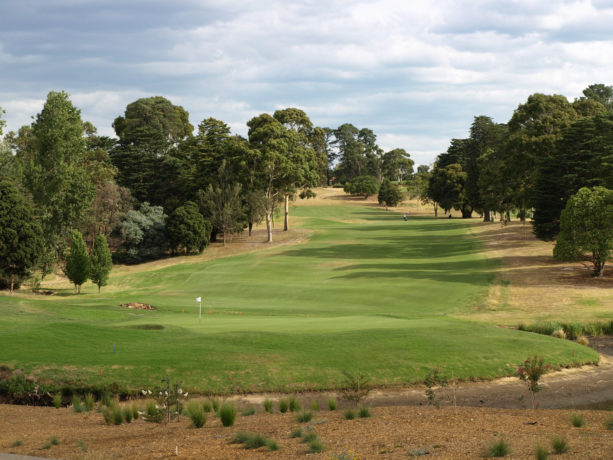
Looking back over the 13th hole
A wide entrance is found to the green between two sand traps, with another two towards the rear. The green is of reasonable size and angles away to the right. Water covers the front, left and rear of this green complex, although a lot of dense rough is found on some of the surrounds. I liked the design of this hole. Risk and reward are offered on all shots, the fairway bunkers, creek and water around most of the green complex, so some thought must be given on how to play. Players of all abilities can confidently play as options are presented to avoid trouble.
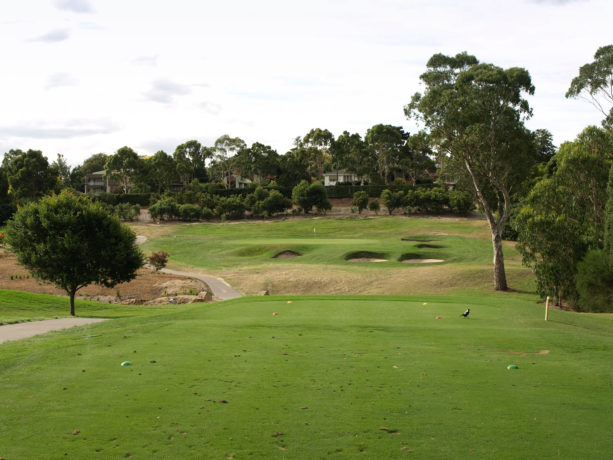
Hole 14 – 149 meter par 3
From the easiest par 5 to the easiest par 3, this mid length hole has some trouble to carry before reaching the green. A small creek sits between the tee and green. Built into a hill, the green sits elevated at the front, with five sand traps and one green bunker along the face and right side.

Heavy rough in front of the 14th green
Anything not hit the correct distance will come to an abrupt halt, with heavy rough surrounding the green complex, unless sand is found of course. The putting surface runs from the rear to front, with some small undulations. I always question how much strategy can really be employed on a one shot hole. The design here really answered that question. A lot more than what is offered. With so much rough on the surrounds this hole is all about hitting the ball onto the green through the air. It is impossible to run the ball in, there is a small portion between the bunkers and green surface that could be changed to shorter grass. Also anything missing the green has to be played through the air to recover. As much as I like the aesthetics of this hole, play-ability is very limited.

Hole 15 – 502 meter par 5
Heading back up the hill is the last par 5 for the day. With a slight turn to the left, a carry over a water hazard is required to reach the wide fairway. This narrows as the bunkers encroach either side, first the left side, then further on the right. Ideally playing to the left will open the angle towards the green.

View from the 15th fairway
There is no further trouble until reaching the green. This sits elevated, built into the hill, with two traps either side and a large false front between. Depending on the side the pin is located, will determine the best angle from the fairway, minimising the carry over the sand traps. Less competent players may struggle with the tee shot, although a forward tee is available preventing the long carry over water. Not as much fun as the previous par 5, but still offers some challenges, asking questions of the player.

Hole 16 – 406 meter par 4
Heading down the hill for the last time is the longest par 4 on the course. With a slight turn to the right, hitting from the elevated tee will shorten the hole, along with the fact it plays down hill to the green.
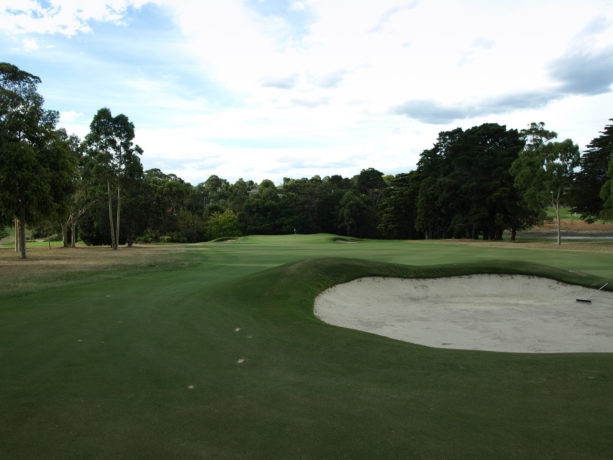
Center line bunker on the 16th fairway
One fairway bunker is located on the right, the line for those trying to shorten the hole, whilst another is located in the fairway a bit further on. Play from the left side of the fairway opens up the angle into the green in my opinion.

View of the 16th green
The green is slightly angle towards the right and is narrow at the entrance. Bunkers sit either side of this, before widening towards the rear. There are a couple of small mounds at the rear, but not much shorter grass, so no bump and run shots can be played. Well layed out hole, with ideal hazard placement. This works well with the green layout, making the player think about where to land the shot.

Hole 17 – 187 meter par 3
The penultimate hole is the hardest par 3 at Woodlands Golf Club. Hitting across a water hazard, this runs up the left side of the hole. There is a large slope from right to left on the ground leading into the green, which brings the water into play for anything slightly off line.

Looking back from the 17th green
Two traps are located at the narrow green entrance, which widens towards the rear. Another two bunkers are found towards the back, with the right and rear sides slightly risen. The hole is framed quite nicely, but the lack of short grass leading in and around the hole has to be questioned. For such a long hole, relying on a carry through the air is unrealistic. Otherwise this would be a very enjoyable hole.

Hole 18 – 282 meter par 4
Finishing the round is a short par 4 which doglegs to the left. First a 100 meter carry is required over a water hazard to reach the fairway. From here a decision needs to be made. Longer hitters may want to take on the cluster of bunkers on the inside of the turn trying to find the green. Otherwise it is picking the best line to layup and make a short approach.

View from the 18th fairway
A row of bunkers are also found on the outside of the turn, making club selection critical. There is a small section of fairway between the fairway bunkers and before the green for those attacking the hole. A small opening is found into the green to run the ball in.
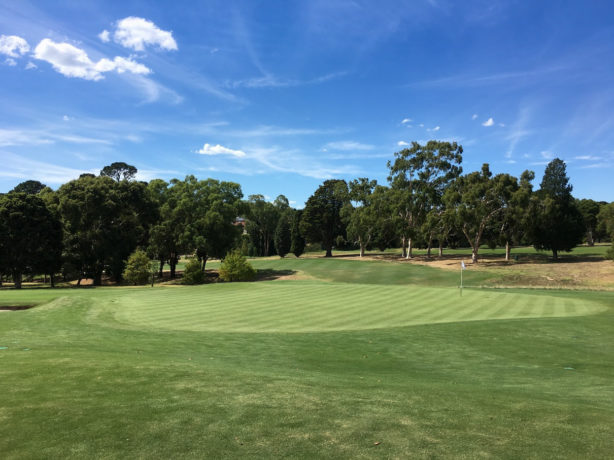
Looking over at the 18th green
I’m undecided on this hole. It offers some risk verse reward with the tee shot. It’s just a case is the risk really worth it, being such a small landing area in front of the green to carry the fairway bunkers. Laying up there is also no real obvious line into the green due to bunker placement, due to being scattered along the front.

Panoramic view of the 13th hole
Looking at the course makeup:
- Hole Directions – There was a lot of variety allowing for conditions to have wide ranging effects during play. This was fairly evenly spread throughout all points of a compass. Although at times holes ran parallel to each other, efforts have been made in the routing to ensure this is kept to a minimum
- Hole Lengths – Par three holes had a good variance in distance, ranging from mid to long, evenly split among the two. Par four holes ranged from short to long with a clear majority in the short category. Par 5 holes were only in the long category. Balance of the par types was good as a whole. When looking at the two nine loops, this was also evenly balanced
- Hole Layout – There was a decent mixture in how the holes played, with an even split in holes turning left and right, where two shots or more were required to reach the green. However there were times were consecutive holes turned in a similar direction and an imbalance between each nine, with a majority of holes turning right on the front and a majority turning left on the back
Overall the conditions were very good. Tees were generally flat with good rotation of hitting areas. The fairways were well maintained, fairly firm allowing for some run on the ball. Bunkers were also well maintained with a consistent amount of sand. Green complexes were indifferent. The putting surfaces were great, but the surrounds were quite mixed. At times the rough was thick, but others barely grown. Certainly cannot fault the conditions of the course.
There were a couple of holes that stood out. I will concentrate on the memorable for the good reasons. Ones I enjoyed were 2, 3, 6, 9, 10, 12 and 13.
In summary the course was a joy to play. There was a good variety in the holes and how they played. I was surprised by the amount of elevation change over the course, expecting it to be much flatter. I couldn’t question the conditions of the course, certainly up to the high standard expected of a private course. My biggest criticism would be the rough being so close to the putting surface on most greens. This really restricted the type of play around the greens, reminding me quite a lot of most American courses.
Riversdale Golf Club is a course I would certainly return to play occassionaly. But it is not a course I would want to play on a weekly basis.
How to play at Riversdale:
1. Be invited by a member
2. Be an interstate or overseas visitor who is a member of a golf club
3. Have a really good handicap and play in the Riversdale Cup

